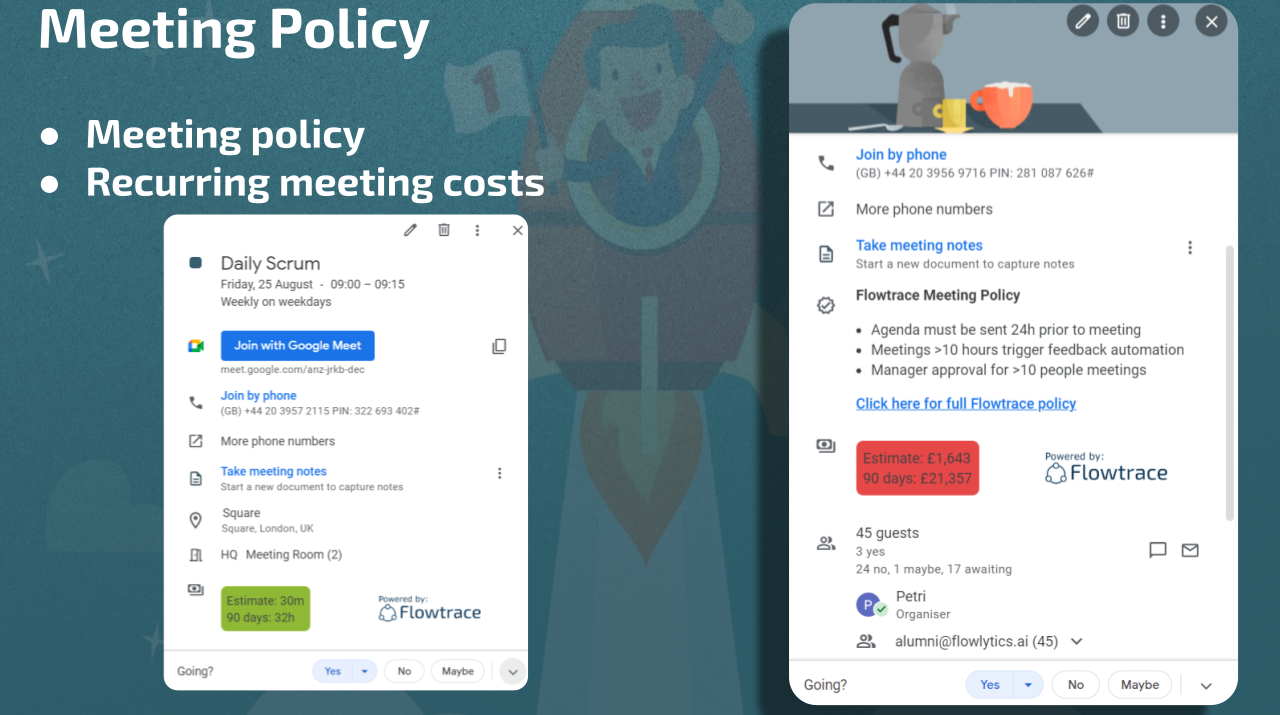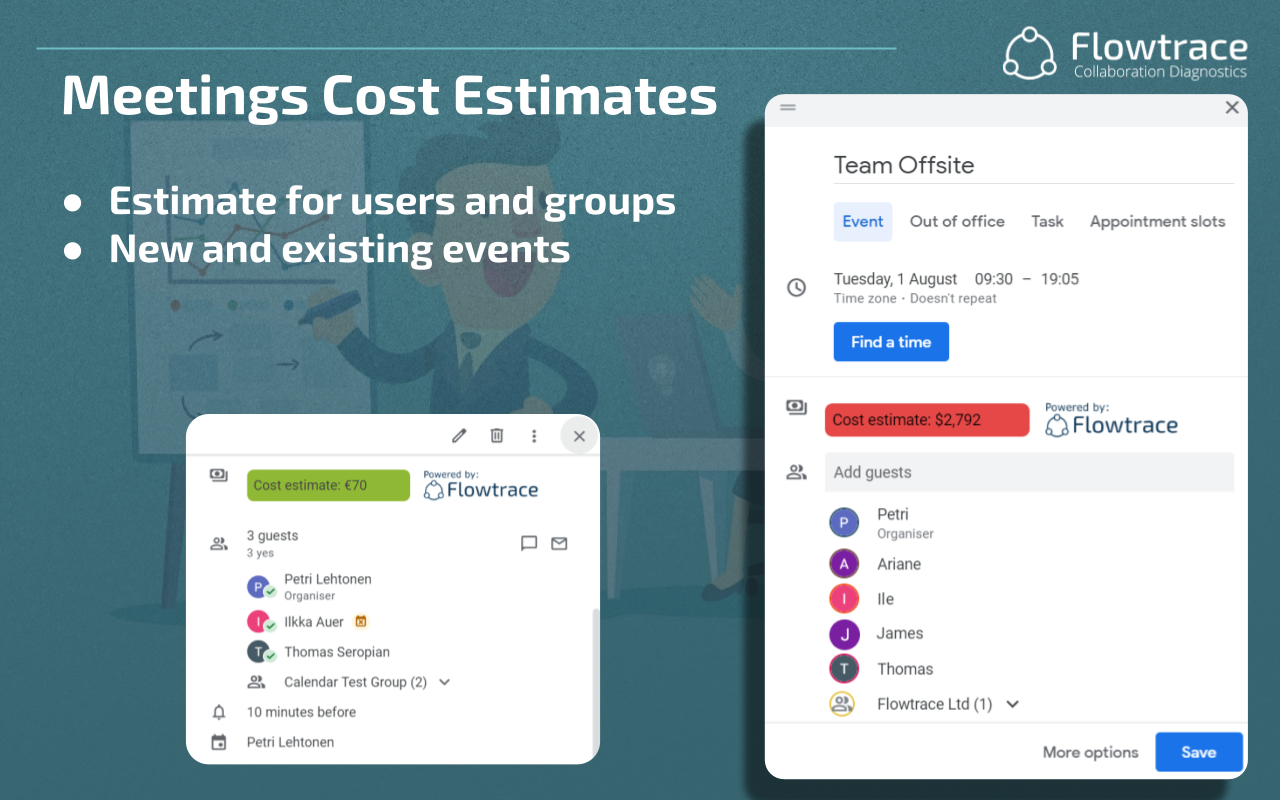Understanding Company Meeting Costs
Understanding and managing company meeting costs is essential for organizational efficiency and financial health. Explore the impact of direct,...
Learn how tracking meeting cost indicators can optimize resource allocation, enhance budget management, and boost productivity in your organization.
Meetings are essential for team coordination and decision-making but managing their cost implications is crucial for organizational efficiency. Meeting cost indicators are metrics that provide insights into the financial impact of meetings. These indicators encompass various aspects, such as the duration of meetings, the number of participants, and the associated salaries, helping organizations understand and manage the resources allocated to meetings.
By tracking these indicators, businesses can make informed decisions to optimize meeting practices. This ensures that meetings are cost-effective and contribute positively to the organization's objectives, balancing the need for effective collaboration with prudent resource management.
.png?width=1366&height=768&name=Outlook%20Add%20In%20Store%20Images%20-%201%20(1).png)
The ability to track and manage meeting costs is essential for optimizing resource allocation, enhancing budget management, and boosting overall productivity. Meeting costs, often unseen, can substantially affect an organization's financial performance, making it imperative to have accurate and actionable cost data.
Meetings involve various direct and indirect costs, from the salaries of the attendees based on their time spent to potential opportunity costs lost in productivity. Without proper tracking, these costs can spiral, subtly draining resources. A meeting cost indicator provides a concrete figure to these often overlooked expenses, allowing businesses to quantify what is typically qualitative—ensuring every meeting is both necessary and productive.
The financial health of an organization can be significantly impacted by poorly managed meetings. For instance, a study by Bain & Company revealed that a single weekly meeting of midlevel managers was costing a large company approximately $15 million a year. This stark statistic highlights the need for stringent management of meeting practices. By understanding the cost implications of meetings, organizations can make informed decisions to cut unnecessary meetings, shorten overlong gatherings, or alter participant lists to minimize costs.
Having precise data on meeting costs helps organizations:
Meeting cost indicators are essential for businesses to maintain control over their internal processes, ensuring that time and money spent in meetings are an investment towards organizational success rather than an unnoticed expense.
Meeting cost indicators include a range of metrics that help organizations assess and manage the financial implications of their meetings.

These components are used both individually and collectively to assess the direct and indirect costs associated with meetings:
Direct Costs: These are straightforward and include the total salaries paid to employees while they are attending the meeting instead of performing other tasks. For example, a report by Doodle highlighted that poorly organized meetings in 2019 led to a cumulative loss of $399 billion in the U.S. alone, underscoring the need for well-planned and purposeful meetings.
Indirect Costs: Indirect costs of meetings might include potential opportunity costs such as delayed project timelines or missed opportunities for sales due to time spent in meetings. While harder to quantify, these costs are essential for understanding the full financial impact of meeting practices.

Implementing meeting cost indicators offers numerous advantages that extend beyond simple cost control, enhancing organizational efficiency and strategic effectiveness.
With clear insights into the actual costs of meetings, leaders can make more informed decisions about which meetings are necessary and how they should be conducted. For instance, understanding the high cost of certain recurring meetings may prompt a review of their frequency or participant list, encouraging more focused gatherings that are only held when absolutely necessary.
Meeting cost indicators enable more accurate budgeting by providing precise figures on one of the less visible expenditures within a company. Organizations can allocate resources more effectively, ensuring that spending on meetings is justified and optimized. This improved budgeting helps in maintaining fiscal discipline and can free up funds for other critical areas.
By quantifying meeting costs, organizations can directly see the impact of inefficient meetings on their budgets. This awareness drives efforts to make meetings more goal-oriented and productive. For example, teams may adopt stricter agenda policies, reduce meeting durations, or refine their objectives, all of which contribute to more effective meetings.
Understanding meeting costs aids in strategic planning by highlighting the need to balance meeting time with other business activities. This leads to better resource management, where time, one of the most valuable resources, is allocated only to meetings that promise real value to organizational goals.
Over time, the implementation of meeting cost indicators can cultivate a company culture that prioritizes efficiency and accountability. As team members become more aware of the costs associated with meetings, there is a natural shift towards valuing time and contributions more significantly. This shift can lead to broader improvements in workplace efficiency and productivity, reinforcing a cycle of continuous improvement.
Accurately measuring meeting costs presents several challenges for businesses, primarily due to the complexity of quantifying both tangible and intangible aspects of meetings. Addressing these challenges is crucial for obtaining reliable data that can inform better management practices.
Track Meeting Frequency

Using Flowtrace, organizations can monitor the frequency of meetings to identify patterns that may indicate inefficiencies. By analyzing how often meetings occur, especially recurring ones, companies can determine whether they are necessary or if some can be consolidated or eliminated altogether. Reducing unnecessary meetings directly helps in lowering costs and freeing up time for more productive activities.
Monitor Meeting Delay Costs

Flowtrace provides insights into the costs associated with delayed meetings. By tracking when meetings start late and calculating the financial impact of these delays, organizations can emphasize the importance of punctuality. Ensuring meetings start on time can significantly reduce wasted resources and reinforce a culture of respect for participants’ time.
Invite the Right Participants
Flowtrace helps organizations optimize meeting attendance by analyzing participant involvement and contribution. Inviting only those whose input is crucial ensures that meetings are more focused and efficient. This not only saves costs associated with unnecessary attendees but also enhances the quality of discussions and decision-making.
Evaluate if the Meeting Can Be an Email
Flowtrace’s meeting analytics can help organizations assess the necessity of meetings by providing data on meeting outcomes and effectiveness. If a meeting’s purpose can be achieved through a quick email or a brief update, Flowtrace can highlight these opportunities, helping to reduce the number of meetings and their associated costs.
Set and Adhere to Agendas

Flowtrace emphasizes the importance of having a clear agenda for every meeting. By tracking meetings that occur without agendas and analyzing their outcomes, organizations can identify the correlation between well-planned meetings and successful results. Setting and adhering to agendas ensures that meetings stay on track, minimizing time wastage and improving overall productivity.
Establish and Enforce Meeting Policies

Flowtrace allows organizations to set and monitor meeting policies, such as limiting the duration of meetings or setting guidelines for necessary participants. These policies help standardize meeting practices across the organization, ensuring that all meetings are purposeful and cost-effective.
Ensure Teams Have Enough Time for Deep Work

Flowtrace tracks the impact of meetings on employees’ deep work time. By analyzing how meetings disrupt focused work, organizations can find the right balance between collaboration and individual productivity. Ensuring that teams have sufficient time for deep work not only enhances productivity but also reduces the indirect costs associated with frequent or poorly timed meetings.
Implementing and utilizing meeting cost indicators effectively within an organization can significantly enhance decision-making processes and resource management. Here are some best practices for integrating these indicators into your business operations:

Meeting analytics and cost calculators are invaluable tools that modern organizations use to streamline the management of meeting expenses. By providing a detailed breakdown of the costs associated with meetings, these tools help organizations to make informed decisions that optimize resources and enhance meeting effectiveness.
Meeting cost calculators simplify the process of determining the financial impact of meetings by automatically calculating the costs based on variables such as the number of participants, their salary levels, and the meeting duration. This automation removes the guesswork and manual calculations previously required, allowing for immediate and accurate cost assessments.
Meeting analytics go beyond simple cost calculations to provide deeper insights into how meetings affect overall business operations. These analytics can track trends over time, identify cost drivers, and help pinpoint inefficiencies in meeting management.
The combination of meeting analytics and cost calculators provides leaders with actionable insights that can lead to significant improvements in meeting management practices.
Understanding and managing meeting costs is essential for maintaining organizational productivity and efficiency. Effective meeting cost indicators play a crucial role in this process by providing clear, quantifiable insights into the true financial impact of meetings. These indicators help organizations identify areas where resources may be underutilized or wasted, enabling targeted improvements that can significantly enhance operational effectiveness.
The integration of meeting analytics and a cost calculator from Flowtrace further empowers businesses to grasp the nuances of meeting expenditures. They offer detailed analyses and actionable data that can transform meeting culture and reduce costs associated with meetings.
Understanding and managing company meeting costs is essential for organizational efficiency and financial health. Explore the impact of direct,...
Optimize your meetings with a data-driven approach. Learn how to analyze key metrics to improve efficiency, reduce costs, and enhance collaboration.
Optimize meeting culture with 5 key metrics for every company. Discover strategies to reduce costs, boost engagement, and enhance productivity in...